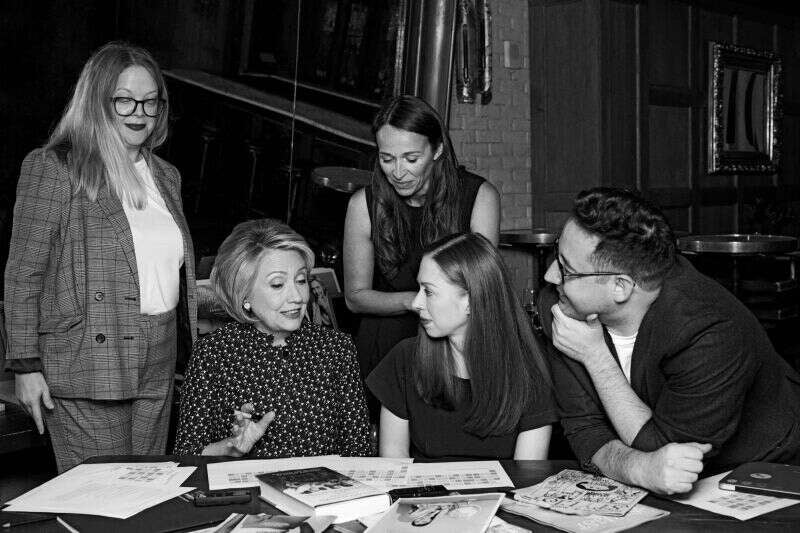
Women’s magazine Stylist has a “long lifespan” in print yet, its editor-in-chief believes, as the free title celebrates its tenth anniversary this year.
Lisa Smosarski (pictured) told Press Gazette the magazine had stayed “eternally stable” with a solid audience and advertiser base since its launch in October 2009 with a distribution of 410,674 copies a week.
Ten years on it still puts out an average of 404,392 copies each week, according to the latest ABC circulation figures.
It’s no small feat in a market struggling with changing reader habits, leading to reduced circulations and falling advertising revenues.

Stylist magazine cover 16 October 2019, guest edited by Hillary and Chelsea Clinton. Picture: Pamela Hanson for Stylist Magazine
Numerous magazines targeted at women, including Marie Claire, Look, Now, Reveal, Glamour, InStyle UK and Star, have all either reduced or entirely stopped printing their titles in recent years.
Not even Stylist’s former stablemate, Shortlist, was immune. The free men’s lifestyle title closed in December last year so the magazines’ owner could put its “full force” behind Stylist.
The company even changed its name from Shortlist Media to Stylist Group.
Because the newsstand has been a “particularly tough place” to be of late, Smosarski said paid-for titles need to “find their point of difference” in order to survive.
“I think it will be hard to be a monthly in this world unless you’re doing something different because I think the frequency and speed with which we consume content makes a slow read quite challenging, unless you use that to your benefit,” she said.
Vogue is an example of a title doing just that, she said.
‘People still love print’
Asked by Press Gazette if she thought Stylist would still be in print in another ten years, Smosarski, who has edited the title since its launch, said: “As we sit here today I’d say yes.
“Looking at how commercially successful it is, looking at the engagement, I do think print has a long lifespan yet.
“Will we still be investing in digital? Do we want to grow that further? Well, yes, we do want to do that too, but I think Stylist – and I suppose a few other mags – prove that print isn’t dead.”
She added: “It’s not the format that is dead, it’s distribution, it’s relevance, it’s engagement with the audience.
“People still love print, it’s just how you get it to them that seems to be the biggest challenge at the moment and luckily with Stylist we have managed to find an answer to that.”
‘Unapologetically feminist’
Stylist is drawing out its birthday celebrations across this year with ten issues from ten guest editors, including actresses Jameela Jamil and Brie Larson (aka Captain Marvel) and writer Caitlin Moran.
Smosarski explained: “We wanted to make the whole year a celebration, particularly in these bleak political times to try and have something that cuts through and gives a bit more fun and energy back to the world.”
This week’s magazine (pictured above) has been guest edited by Hillary Clinton and her daughter Chelsea, with the former Presidential candidate praising Stylist for having an “unapologetically feminist” point of view.
Smosarski said jetting to New York to work with the Clintons was a “pretty mind-boggling and special moment”.
She was impressed with Hillary’s understanding of the brand, which Smosarski said speaks to women “in the way that we speak to one another – as we do with friends”.

Stylist team and Hillary and Chelsea Clinton planning their guest edited issue of the magazine. From left: Entertainment Director Helen Bownass, Hillary, Editor-in-Chief Lisa Smosarski, Chelsea and Specials Director Tom Gormer. Picture: Stylist
When the title launched ten years ago many women’s newsstand titles were “homogenised” and did not speak to them as individuals, she added.
“We were very open about our agenda which was to speak to women in all facets of their lives and that was not about pleasing a partner or how to keep your man happy, it wasn’t about gossip, it wasn’t about negative paparazzi pictures, it wasn’t all the things people were seeing in magazines, but it was challenging what was happening in their day-to-day lives.
“As women we’ll talk about politics, we’ll talk about issues at work or going for a promotion or office politics, we would happily then switch to talking about something happening in the news or what we’re going to wear to an event at the weekend.”
Stylist to stay free
Stylist has also regularly campaigned to make women more visible in all walks of life, including sport, the media and the boardroom.
“We have a powerful platform and a large voice and I think it’s really important for us to use that on behalf of the audience that engage with us,” Smosarski said.
Stylist has been distributed for free since its launch. It is currently handed out at train stations in six UK cities and is available for pick up in other locations such as airports, leisure centres and shops.
Smosarski said the group would “never make Stylist a paid-for title”.
“Like everyone we might explore different ways of monetising content elsewhere, but certainly not with the magazine,” she said.
The print and digital sides of the business are now seen as being “equally important” at Stylist.
The latest available company accounts for Shortlist Media – published in March 2018 before the group rebranded – stated an expectation that digital revenues would overtake print within three years.
The Stylist website reaches 2.19m monthly unique visitors each month, according to the latest Comscore figures.
Smosarski said this put it alongside digital natives like women’s lifestyle website Refinery 29, which she pointed out doesn’t benefit from the additional engagement that comes from a print title.
Print is ‘beating heart’ of brand
Stylist currently has a digital editorial team of nine staff, plus six dedicated to video. Its print editorial team numbers 21, while there are two staff members working on the Stylist Loves email newsletters.
Diversification into email newsletters and events has also been essential, Smosarski said, both because the Stylist audience wanted to engage with the brand in different ways, as well as just being what a brand “needs to offer these days”.
“I think waiting for any sort of frequency of printed publication isn’t enough, you need to be able to engage on a daily, hourly basis, you need to know that that brand represents you and your life and therefore we are in the places that our audience are – like Instagram,” Smosarski said.
“So we’re accessing lots of different women, but the print magazine still sits at the middle of that as a beating heart.
“I think we will continue to invest in those other platforms, we will continue to invest and grow digital, but I do think print will remain a solid and important bit of our brand as we go forward into the next ten years.”
Picture: Stylist
Email pged@pressgazette.co.uk to point out mistakes, provide story tips or send in a letter for publication on our "Letters Page" blog

